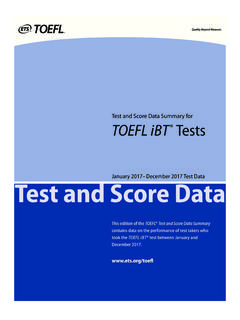Transcription of Big data: changing the way businesses compete …
1 Insights on governance, risk and compliance April 2014. Big data changing the way businesses compete and operate Contents Introduction Big opportunities, big challenges .. 1. What is big data ? .. 2. Big data life cycle .. 5. Big data and analytics .. 6. Big data drivers .. 9. Governance .. 10. Management .. 12. Architecture .. 14. Usage .. 16. Quality .. 18. Security .. 20. Privacy .. 22. Conclusion Big data has big potential .. 25. Next moves .. 26. Introduction Big opportunities, big challenges The idea of data creating business value is not new, however, the effective use of data is becoming the basis of competition. Business has always wanted to derive insights from information in order to make better, smarter, real time, fact- based decisions: it is this demand for depth of knowledge that has fueled the growth of big data tools and platforms. Those leading the change are now including big data from both within and outside the enterprise, including structured and unstructured data , machine data , and online and mobile data to supplement their organizational data and provide the basis for historical and forward-looking (statistical and predictive) views.
2 Big data will fundamentally change the way businesses compete and operate. Companies that invest in and successfully derive value from their data will have a distinct advantage over their competitors a performance gap that will continue to grow as more relevant data is generated, emerging technologies and digital channels offer better acquisition and delivery mechanisms, and the technologies that enable faster, easier data analysis continue to develop. While the ability to capture and store vast amounts of data has grown at an unprecedented rate, the technical capacity to aggregate and analyze these disparate volumes of information is only just now catching up. This report explains what big data is and how you can benefit from using it in your business operations, especially in the field of analytics. Using our in-depth client knowledge, we outline some of the opportunities already grasped by global organizations. In addition, we also highlight some of the key risks some you may already be aware of, but others that may be new to you when you join the big data revolution.
3 Big data changing the way businesses compete and operate | 1. What is big data ? Big data refers to the dynamic, large and disparate volumes of Evolving technology has brought data analysis out of IT backrooms, data being created by people, tools and machines; it requires and extended the potential of using data -driven results into every new, innovative and scalable technology to collect, host and facet of an organization. However, while advances in software and analytically process the vast amount of data gathered in order to hardware have enabled the age of big data , technology is not the derive real-time business insights that relate to consumers, risk, only consideration. Companies need to take a holistic view that profit, performance, productivity management and enhanced recognizes that success is built upon the integration of people, process, shareholder value. technology and data ; this means being able to incorporate data into their business routines, their strategy and their daily operations.
4 Big data includes information garnered from social media, data from internet-enabled devices (including smartphones and tablets), Organizations must understand what insights they need in order to machine data , video and voice recordings, and the continued make good strategic and operational decisions. The first part of the preservation and logging of structured and unstructured data . It is challenge is sorting through all of the available data to identify typically characterized by the four V's : trends and correlations that will drive beneficial changes in business behavior. The next step is enriching this organizational information Volume: the amount of data being created is vast compared to with that from sources outside the enterprise; this will include traditional data sources familiar big data sources, such as those created and stored online. Variety: data comes from different sources and is being created In a business environment that constantly and rapidly changes, by machines as well as people future prediction becomes more important than the simple Velocity: data is being generated extremely fast a process that visualization of historical or current perspectives.
5 For effective never stops, even while we sleep future prediction, data analysis using statistical and predictive modeling techniques may be applied to enhance and support the Veracity: big data is sourced from many different places, as a organization's business strategy. The collection and aggregation result you need to test the veracity/quality of the data of big data , and other information from outside the enterprise, enables the business to develop their own analytic capacity and The four V's capability, which for many years has only been available to a few larger organizations. Click stream Active/passive sensor Log Event Unstructured Printed corpus Volume Variety Semi-structured The impact of big data Speech Structured Social media Traditional Big To understand the impact of how data has transformed our data daily lives, look no further than how the movie rental experience Speed of has changed. When movies were rented from independent Untrusted generation Velocity Veracity Uncleansed neighborhood stores, the rental agent would base their Rate of analysis recommendations on which movies the customer said they liked and a large amount of their own opinion.
6 Today, movie rental companies and content delivery services can utilize a vast array of data points to generate recommendations. By analyzing what was viewed, when, on what device (and even whether the content was fast forwarded, rewound or paused), as well as user activities such as internet searches, and browsing and scrolling within a webpage, recommendations can be tailored for millions of customers in real time andapproximately 75% of views at a leading provider are now driven by these recommendations. 2 | Big data changing the way businesses compete and operate Technology megatrends The term Big data has become a major theme of the technology media, but it has also increasingly made its way into many Big data is generating an intense amount of attention among compliance, internal audit and fraud risk management-related businesses , media and even consumers, along with analytics, cloud- discussions. In EY's Global Forensic data Analytics Survey 2014, based technologies, digital channels and data visualization.
7 These are 72% of respondents believe that emerging big data technologies can all part of the current diverse ecosystem created by the technology play a key role in fraud prevention and detection. Yet only 7% of megatrends. Some even herald the potential transformative power respondents were aware of any specific big data technologies, and of the current trends as rivaling that of the internet. Yet, as in the only 2% were actually using them. early days of the internet, there is uncertainty about just what big Forensic data analytics (FDA) technologies are available to help data is, its potential benefits and the associated risks. companies keep pace with increasing data volumes, as well as EY's 2013 Global Information Security Survey results indicate that business and regulatory complexities; examples can include while adoption and use of big data is not yet widespread, there is real-time analytical processing engines that make rapid business growing confidence and familiarity with the technology.
8 Respondents decisions, such as stopping a potentially improper payment or ranked big data technologies as being around the corner ( , those business transaction, or leveraging anti-fraud/anti-corruption that have been on organizations' radar for a period of time but may monitoring controls that integrate data visualization, statistical not yet be implemented or widely adopted) as average in terms of analysis and text mining. Yet despite their availability, many level of importance, familiarity and confidence in their capabilities companies have not scaled up their data usage to take advantage to address related cyber risks. Organizations typically view these of these effective tools, and may be missing important fraud technologies as offering opportunities to improve their performance prevention and detection opportunities by not mining larger data and create competitive advantage. This is where familiarity and sets to more robustly monitor business activities. confidence in capabilities needs to increase today, as the importance of these technologies is likely to grow significantly in the near future.
9 Emerging technologies and trends 70. Software applications Smartphones and tablets 60 Current technologies Con dence incapabilities (% of respondents). Current technologies Around the corner Web-based applications 50 On the horizon Social media (Size of data points represent importance to survey respondents). 40. Enterprise application store Supply chain management 30. Big data Around the corner Internet of things Bring your own cloud Digital money Cloud service brokerage 20. In-memory Cyber havens computing 10. On the horizon 0 10 20 30 40 50 60 70 Source: Under cyber attack: EY's Global Information Security Survey 2013. Familiarity with technologies and trends (% of respondents) Big data changing the way businesses compete and operate | 3. Big data eliminates intuition Decisions can be made with a structured approach through data -driven insight, including: Customer and product profitability Customer acquisition and retention strategies Customer satisfaction strategies Marketing segmentation Operations and performance management Supply chain and delivery channel strategy Big data life cycle Creation Output Certain types of data have long been able to be captured, but this Although it is now easier and cheaper to capture, store and data has rarely been used effectively until now ( , the location of a process data , it is not useful unless the information is relevant.)
10 Person at any point in time, the number of steps a person takes every it must also be readily available to the right people who need the day, a real-time history of credit card purchases). New technology appropriate input in order to make insightful decisions leading to such as advanced sensors and customized software can now record successful outcomes. this information for analysis. There are three key enablers: Changes in the way we communicate ( , social media vs. telephone Mobile established mobile networks have allowed for easier vs. text/SMS vs. email vs. letter) have also increased our ability to distribution of information in real-time investigate areas such as consumer sentiment. Social media increases the speed at which data is generated; for example, a product launch Visual/interactive technologies have brought the ability to review large and complex data sets into the realm of the average that is discussed live on a popular social networking site can business user generate a buzz in real-time and allow companies to gauge public reaction even before the launch event is over.















